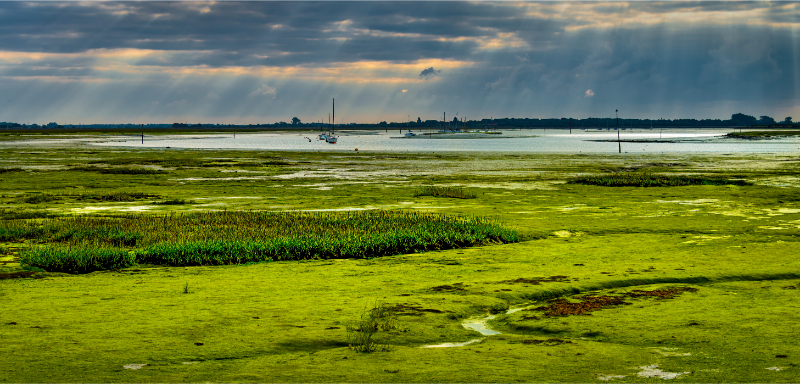Water quality is an emotive topic – both around Chichester Harbour and for waterways across the UK. The green swathes of macroalgae weed across the harbour’s mudflats in the summer are a visual representation of the excess nutrients in the water and reports of sewage discharges into rivers and seas have dominated news headlines in recent years.
Poor water quality has an impact on people, wildlife and the habitats and ecosystems of Chichester Harbour. But what are the sources of pollution affecting our water quality, and what can be done to address the issues?

Sewage discharges
The best known of the pollution sources is the release of untreated sewage into waterways. The UK’s outdated wastewater infrastructure means that rainwater drains from buildings and roads into wastewater treatment works alongside our wastewater. During heavy rainfall the system becomes overwhelmed and untreated sewage is released into waterways via Combined Storm Overflows (CSOs). Pressure has mounted on water companies, including Southern Water, to make meaningful infrastructure improvements and there is a programme of work underway. As individuals we can make small differences, using water butts and planting to reduce rain run-off from our properties and avoiding blocking the sewage system, with cooking fats, wipes and other items.
Agriculture
Farmers often use nitrates and phosphates as a fertiliser to grow crops. But not all the fertiliser applied to the land is taken up by plants and when it rains the excess leaches into the ground or is washed into watercourses. Although the catchment for the harbour is huge, many farmers around Chichester Harbour are working with the Farming in Protected Landscapes team at Chichester Harbour Conservancy to reduce their use of fertilisers and farm with a view to improving water quality.
Boating
Boating can impact on water quality, from the release of sewage from onboard toilets, to the “antifoul” chemicals used on vessel hulls. The heavy metals and biocides in most antifoul treatments are toxic to marine life and can leach into the water. Antifoul chemicals often enter the water when scraped or removed without due care. Boaters can install holding tanks and use the free pump-out facilities at Itchenor to dispose of sewage, choose eco-friendly siliconebased antifoul like the one applied to our solar-powered tour boat and follow RYA environmental best practice guidelines for removing and replacing antifoul.
Plastics
Plastics in the ocean are another well-known source of pollution, brought to widespread attention by David Attenborough’s Blue Planet. Entering the water from litter, urban run-off, plastic boats, discarded fishing gear and more, a study has found microplastics within shellfish in Chichester Harbour.
Chemicals and Pharmaceuticals
A wide range of chemicals and pharmaceuticals, including forever chemicals that don’t break down, are also found in the water. A 2023 study found more than 50 compounds in water samples collected by the Clean Harbours Partnership ranging from prescribed and illegal drugs to pesticides. Some pharmaceuticals impact on the behaviour, biological make-up and reproductive success of marine organisms including shellfish.
The Future
Chichester Harbour Conservancy is focussed on nature recovery within the harbour, including coastal habitats and water quality. We are working with partners and universities as well as applying pressure to organisations to better understand and improve the water quality situation.